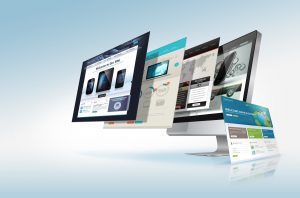It’s easy to get caught up in the latest technologies and advances in website design. However, without a solid foundation, all the bells and whistles will only serve to frustrate visitors to your site.
So before you consider adding features to your site, take a look at this list of 5 basic things that every website needs in order to grow engagement and conversions:
Clear Navigation
There’s no coincidence that most website navigation is at the top or left-hand side of the webpage.
In general, people view websites in an F pattern, with the majority of focus traveling from the top left of the page. Navigation elements that are hidden on the side or the bottom of the page may be missed by visitors.
This leads to loss of engagement as people won’t necessarily figure out where to go from the main page. To avoid this, keep your navigation in a highly visible area of the page, and make the navigation menu in obvious contrast from the rest of the page.
Bread crumbs are another navigation tactic commonly employed to improve user experience. By keeping a dynamic “you are here” menu available at all times, you can reduce the chances that visitors will get lost on a site with large amounts of content.
Logical Organization
Hand-in-hand with having clear menu options is having a logical organizational structure for your website. This is especially important on sites with multiple categories and subcategories as there is a greater chance for user confusion and website abandonment.
Sites such as iPerceptions and UsabilityHub provide you with the means to see if your link hierarchy and website organization make sense to your website’s visitors before you change anything on your website.
Another benefit of using the type of organization expected by customers (versus your own in-house organizational structure) is that more people will find exactly what they are looking for, which can improve conversions and sales.
Related Links
Linking to related content within pages helps to increase visitor interest. Keeping visitors on your site for a longer period of time increases the chances of conversions and sales.
Related links are most often seen on blog posts and product pages, but they can also be used in other ways such as:
- Linking to case studies and/or presentations on sales pages
- Linking to deeper/more specific information from general subject pages
- Linking to multimedia content from within reports or other text-based information
Related links serve an important function in SEO as well. Google is better able to crawl your site and find more of your pages when those pages are linked from multiple sources within your own site. This raises the chances to rank for highly relevant content that may not be on the main pages of your site.
Visual Cues
The visual elements of your website serve an important purpose in guiding users as they navigate. Use contrasting colors for buttons and other interactive features on your site to draw the eye of your visitors and get them to click.
Other visual elements to consider:
- Icons – specific icons for pdfs, videos, and other files can help users find what they need consistently.
- Images – people tend to read the captions on images more often than the full text of an article or web page. Optimize your images to provide relevant supporting information to improve engagement and conversion.
- Progress & Forms – arrows, color indicators, and progress bars help to guide customers through the ordering process and can make users feel more secure with the transaction.
Dynamic Content
Most dynamic content takes one of two forms – content that is explicitly tailored to a particular visitor and content that is tailored to specific visitor actions.
Personalization can create a better customer experience by tailoring your messaging to the needs and interests of each visitor.
And by providing dynamic offers or based on customer actions, you can increase the chances of making a sale.
For example, if you’ve ever abandoned an online purchase, you’ve likely received an email “reminding” you that you left something in your cart. You may have even received a special coupon or offer designed to incentivize you to buy.
Another way dynamic content is often used is to show subscribers or members different information versus people who have yet to purchase.
Your Turn…
Which of these five things do you think is most important for your website? Let us know.

